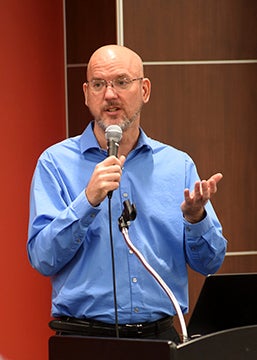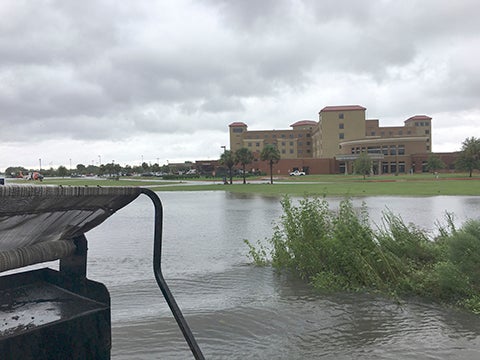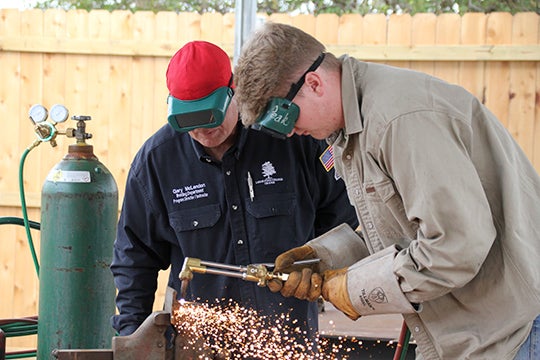BEYOND THE STORM — Refuge in the flood: Medical Center of SE TX became a virtual island
Published 4:28 pm Tuesday, May 1, 2018
Richard Gonzalez knew the score the day before the skies fell on Port Arthur.
Gonzalez, president of The Medical Center of Southeast Texas, got the word from Jefferson County emergency management folks: If Tropical Storm Harvey went south on this community, the medical center would be largely on its own, at least initially.
“No one will be able to get there to help you for a couple of days,” he was told.
Not that Gonzalez and his staff hadn’t prepared. They’d followed the storm’s path for two weeks, followed its landfall near Rockport, Texas.
They stocked up on supplies, food, water, sheets. The medical center’s 800-plus employees were well prepared to provide care for the patients at the 216-bed facility.
What they couldn’t know — what no one could know — was that the Tropical Storm would hover over Coastal Texas for three days, dumping some 63 inches of rain in the area, rendering the medical center a virtual island in Port Arthur.
They couldn’t know that the flooding around the facility would force the hospital to become a shelter for local people with nowhere else to go, that patients’ family members would bring extended family and even pets to the facility. That hungry and forlorn folks would wash up at the hospital’s doorstep, demanding to be fed and lodged.
Here’s how peculiarly Tropical Storm Harvey played out at the medical center:
• The morning after the storm launched, a woman 26 weeks pregnant was treated after experiencing contractions. She’d arrived on a Jet Ski.
• On the first night of the storm, an ambulance delivering patients to the Emergency Room was unable to leave the medical center because of rapidly rising water. The rescuers were trapped.
• At least 80 patients treated at the ER were unable to leave the facility because of flooding. They began to demand food and water and blankets. “We began to be a shelter,” Gonzalez said. “We’re not meant to be a shelter.” And yet, hospitals are seen to be places of refuge.
Not the storm
they expected
This was not the hurricane Gonzalez and the medical center expected. In Hurricanes Rita and Ike, the hospital had closed. But it was the hurricane the medical center got, and its staff rose to the needs of its patients, hospital leaders said.
The day after the storm, the hospital had two
open-heart surgeries. Hospital staff began receiving patients by boat, by helicopter, by dump truck, by any vehicle that rode high enough that it could negotiate 5 feet of water that represented a moat around the facilities.
And yet there were upsides. The facility itself didn’t flood, although water threatened the loading dock. Utilities stayed on. Some staff could be shuttled back and forth from a staging area on Highway 365.
There was ample room to house about 70-80 staff members who stayed at the hospital, Chief Nursing Officer Deborah Vaughn said: an auditorium and some classrooms — men in some spaces, women in others. An ob-gyn stayed at the hospital; so did someone for anesthesiology.
There were unexpected challenges, too, including discharged patients who could not — or sometimes would not — leave in the first few days. Texas Rangers arrived within a couple of days and began the process of winnowing down the number of hospital guests, sending most to Jack Brooks Regional Airport.
Those pets? They were moved to Ford Park, where a pet shelter was established. Police stayed in the ER, encouraging order.
Supplies were sufficient, even abundant in some cases. The community sent blankets and bottled water, so much water that the hospital began to supply the National Guard with fluids at the mall.
ER: Packed for days
The ER remained packed for days.
“Post flood, we saw a lot of respiratory problems,” Vaughn said. “It could have been due to the mold.”
Cellulitis — skin infections — there were many cases of that. There were rashes and lower gastrointestinal problems.
The medical center treated patients for hypothermia and for “general chronic illnesses.” Some patients came to the medical center because they lost their medicines. The staff tried to help everyone.
Katie Marioneaux, director of emergency services, said the staff gave firefighters tetanus shots because the water in which first-responders were wading and making rescues was unclean. Yet, they saw no cases of tetanus.
Nor were there many animal bites: no snake bites, no alligators.
But there were patients, a steady stream. Helicopters brought some; trucks, others.
Those who were “significantly ill” were transferred to Dallas or to hospitals in Louisiana. Others got their treatment to the best of the medical center’s ability.
Chris McMahon, the hospital’s chief operations officers, said helicopters landed, sometimes two at a time. Two would depart, two would land.
The day after the storm, Marioneaux herself accompanied a patient to Houston on a helicopter.
Dialysis: A challenge
Dialysis patients proved to a challenge. They began to arrive at the medical center because kidney treatment facilities in the area were closed. About 17 showed up on a bus.
Medical staff checked them: Some were well enough to return home, others stayed. But the medical center knew it needed some additional equipment and staff for kidney treatment and a dialysis facility with nursing staff was established on campus.
A mobile unit was set up in Beaumont, where The Medical Center of Southeast Texas has an 80,000-square-foot, 12-bed surgery center that remained open. There, Beaumont campus administrator Becky Ames said, the facility tried its best to provide local care and to coordinate services with their Port Arthur colleagues.
Handling dialysis patients proved to be the biggest medical challenge.
Logistically, getting staff to and from the hospital was a challenge. The parent company sent relief staff from hospitals out west; for a couple of weeks, state certification processes were relaxed so the relief nurses could provide backup to the medical center staff.
Personnel challenges
There were other, personal challenges for personnel. The parking lot was full of cars, many belonging to the staff, destroyed in the resting floodwaters. In fact, Gonzalez said, about 100 staff members lost “everything”; about 300 lost something.
Later, in the storm’s aftermath, adrenaline faded and staff members realized their homes were flooded and their personal lives turned topsy-turvy. There was some personal anguish.
One staff member, a scrub tech, died in the floodwaters. That weighed heavily on the staff, but they soldiered on.
Personal losses and the sense of uncertainty about what they would find when they returned home weighed on the staff. The counseling staff that helped patients later counseled staff members before they went home.
With the arrival of nurses from Utah and Arizona, some nurses got to go home for the first time in days — if roads were open. At various times, highways 73 and 105 were closed. Both sides of Interstate 10 were closed. Vaughn said her first trip to her Bridge City home took more than five hours to complete.
Marioneaux stayed at the hospital a week. On her first trip home, she stopped at H-E-B and police officers were guarding what sparse food supplies were available.
Gonzalez stayed at the hospital for two weeks, sleeping on a mattress on the floor. But he saw wondrous things, including a volunteer spirit that he said he wishes would never go away.
One community volunteer was sweeping the floor; he just came to the hospital to help and would not be dissuaded from doing so. One doctor treated the staff — perhaps hundred of people — to several meals made at a local restaurant at his own expense. Community members showed up at the hospital in high-riding vehicles, providing needed, volunteer transportation all day for many days.
Marioneaux said there was never panic among staff members, despite unusual circumstances. Amid the chaos of the circumstances, there was order and routine among the staff.
Proud of their work
Would they do anything differently, if it happened again?
That’s hard to say.
But pride in the hospital’s performance remained evident among the medical center leaders seven months after the crisis.
A Homeland Security official visited from Washington, curious about how the hospital in Port Arthur could stay open and serve its community in the middle of a flood, how it could be an island of hope and refuge in a sea of natural catastrophe and despair.
How did they do it?
McMahon said when the crisis passed, hospital leaders and staff themselves expressed some sense of wonder about what had happened, about what they and their colleagues, pressed to the max in dire circumstances, had done.
Others recalled their recent experiences in a blur.
“Did that just happen?” some asked.
It did.
This story appeared in Volume 2 of The Port Arthur News Profile, April 15, 2018
More Profile





